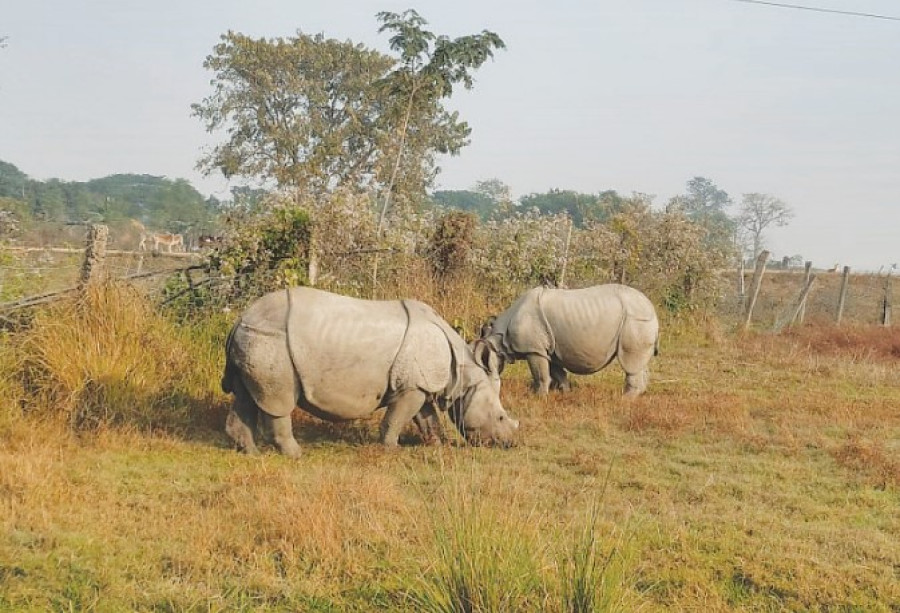Climate & Environment
Efforts on to make Koshi Tappu a rhino habitat
A male rhino from Chitwan National Park will soon be paired with two female rhinos at Koshi Tappu Wildlife Reserve for natural breeding.
Binod Bhandari
Conservationists are optimistic about developing the Koshi Tappu Wildlife Reserve, often dubbed as the capital of wild water buffaloes (Arna in Nepali), into a major habitat for one-horned rhinoceros.
As Pushpa and Anjali, two rhinos aged four and three years, respectively, which were moved to the reserve last year—are thriving in their adopted home, conservationists are now aiming for natural breeding of this endangered species in Koshi Tappu. “After the successful translocation of Pushpa and Anjali some six months ago, a male rhino named Meghauli has been brought to Koshi Tappu from the Chitwan National Park. It is expected that the rhino population will flourish in Koshi Tappu,” said Ramesh Kumar Yadav, chief of the Koshi Tappu Wildlife Reserve.
Pushpa and Anjali were introduced to Koshi Tappu, the country’s only wildlife reserve, on September 27 last year. They were both rescued in Chitwan at different times. Pushpa was rescued at the age of two, separated from her mother, while Anjali was just one month old when she was rescued. Both of them were raised under human care in Chitwan before being released into their natural habitat in May this year.
The reserve decided to bring Meghauli, the eight-year-male rhino, as the reserve area is found favourable for the pachyderms and there are no hunting animals like tigers and leopards in the reserve’s forests.
The Federal Ministry of Forest and Environment, based on the recommendations of conservationists and technicians, a few months ago granted permission for the translocation of six rhinos from the Chitwan National Park. Federal Minister for Forest and Environment Nawal Kishor Sah formally handed over the male rhino to the reserve on Saturday.
Pushpa and Anjali have been kept in a fenced territory near Pathari Wildlife Rescue Centre in Saptari district. Around two hectares of forest land has been allocated as pasture for the translocated rhinos. “Meghauli is currently kept in a cage. He will be released soon to join Pushpa and Anjali," said Birendra Gautam, Koshi Conservation Centre chief of the National Trust for Nature Conservation (NTNC). According to him, Pushpa and Anjali have been adapting well to their new surroundings and haven’t shown any abnormal activities.
In 2017, sixteen water buffaloes had been translocated to Chitwan from the Koshi Tappu Wildlife Reserve despite protests from Koshi Tappu locals and some conservationists. They were housed in a 30-hectare enclosure at a grassland in Padampur area, Chitwan. However, the water buffaloes translocation had been a fiasco. All the shifted bovines died within five years due to the constant floods and tiger attacks.
Conservationists are optimistic regarding the successful adoption of rhinos in Koshi Tappu Wildlife Reserve. They hope that the pachyderms will be safe in the reserve as there are no tigers and leopards to hunt the pachyderms.
The reserve, spread over an area of 176 sq km in Sunsari, Saptari and Udayapur districts, was established in 1976. As per the latest census conducted in 2021, there are a total of 498 water buffaloes in the reserve. It is also home to 20 other animal species including wild elephants, hog deer, wild boar, spotted deer, blue bull, and rock python among others.
The Koshi Tappu Wildlife Reserve is a major destination for birding in Nepal. A total of 441 bird species are found in the reserve. According to conservationists, Koshi Tappu Wildlife Reserve and its vicinity is a major habitat of winter migratory birds in the country. As per the aquatic bird count held this year, a total of 5,527 birds of 53 aquatic species have been recorded in the area.




 8.12°C Kathmandu
8.12°C Kathmandu











